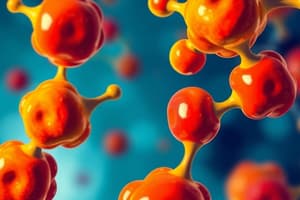Podcast
Questions and Answers
What are the primary causes of dyslipidemia?
What are the primary causes of dyslipidemia?
- Lifestyle choices
- Genetic disorders (correct)
- Dietary fats
- Infections
What is the threshold level for elevated triglyceride levels?
What is the threshold level for elevated triglyceride levels?
- > 250 mg/dL
- > 100 mg/dL
- > 200 mg/dL (correct)
- > 150 mg/dL
Which demographic is at a higher risk for developing dyslipidemia?
Which demographic is at a higher risk for developing dyslipidemia?
- Men over 40 years (correct)
- Women in their 20s
- Children
- Teenagers
What effect does ApoC-II have in lipid metabolism?
What effect does ApoC-II have in lipid metabolism?
Which condition is NOT a secondary cause of dyslipidemia?
Which condition is NOT a secondary cause of dyslipidemia?
What is the role of the PCSK9 gene in dyslipidemia?
What is the role of the PCSK9 gene in dyslipidemia?
What characterizes stable plaque in atherosclerosis?
What characterizes stable plaque in atherosclerosis?
Which lifestyle factor is associated with increased risk of dyslipidemia?
Which lifestyle factor is associated with increased risk of dyslipidemia?
What is the primary role of lipoproteins in lipid metabolism?
What is the primary role of lipoproteins in lipid metabolism?
Which lipoprotein is primarily responsible for reverse cholesterol transport?
Which lipoprotein is primarily responsible for reverse cholesterol transport?
What condition is defined by elevated blood levels of cholesterol, triglycerides, and/or lipoproteins?
What condition is defined by elevated blood levels of cholesterol, triglycerides, and/or lipoproteins?
What are Chylomicrons primarily composed of?
What are Chylomicrons primarily composed of?
What is the function of Lipoprotein Lipase (LPL)?
What is the function of Lipoprotein Lipase (LPL)?
Which of the following lipoproteins is known for its role in transporting lipids from the liver to peripheral tissues?
Which of the following lipoproteins is known for its role in transporting lipids from the liver to peripheral tissues?
What is the consequence of hyperlipoproteinemia?
What is the consequence of hyperlipoproteinemia?
Which type of lipoprotein is primarily involved in lipid digestion and absorption?
Which type of lipoprotein is primarily involved in lipid digestion and absorption?
Flashcards are hidden until you start studying
Study Notes
Lipid Metabolism
- Fats are crucial for diet; they enhance taste and texture, serve as a primary energy source, and facilitate the absorption of essential vitamins.
- Fats can be converted to other important molecules such as prostaglandins.
Lipoprotein Overview
- Lipoproteins are complex particles with a hydrophobic core of non-polar lipids, essential for lipid transport in the body.
- Functions include:
- Absorption and transport of dietary lipids in the small intestine.
- Transporting lipids from the liver to peripheral tissues.
- Facilitating reverse cholesterol transport from peripheral tissues back to the liver and intestine.
Lipid Digestion
- Chylomicrons are large particles containing triglycerides and cholesterol, surrounded by a phospholipid membrane with apolipoproteins for solubility in body fluids.
- Lipoprotein Lipase (LPL) is crucial for hydrolyzing triglycerides, enabling the release of free fatty acids.
Dyslipidemia
- Characterized by abnormal blood levels of cholesterol, triglycerides, and/or lipoproteins, leading to hyperlipidemia.
- Major types include:
- Hyperlipidemia (HLD): Refers to elevated cholesterol, triglycerides, or lipoproteins.
- Hypercholesterolemia: Total cholesterol levels exceed 200 mg/dL.
- Hypertriglyceridemia: Elevated triglycerides above 150 mg/dL.
- Prevalence is higher with age, and men are more affected than women.
- It is a significant risk factor for coronary artery disease and atherosclerosis.
Causes of Dyslipidemia
- Primary (Familial): Resulting from polygenic inheritance.
- Secondary (Acquired): Associated with:
- Lifestyle factors such as obesity, smoking, and heavy alcohol consumption.
- Systemic illnesses including diabetes mellitus and hypothyroidism.
- Certain medications like thiazide diuretics and oral estrogens.
Atherosclerosis
- The fatty streak phase includes the adhesion of blood leukocytes to activated endothelial cells.
- During plaque progression, a fibrous cap forms, composed of smooth muscle cells, collagen, proteoglycans, and elastin, leading to stable plaques.
- Smooth muscle cells migrate and stimulate extracellular matrix production, further contributing to plaque stability.
Fredrickson Classification of Inherited Hyperlipidemias
- Type I HLP: Deficiency in ApoC-II, affecting the activity of lipoprotein lipase and triglyceride hydrolysis.
- Type II HLP: Involves Apolipoprotein B-100, essential for VLDL assembly and secretion, with the PCSK9 gene regulating cholesterol levels.
Studying That Suits You
Use AI to generate personalized quizzes and flashcards to suit your learning preferences.




